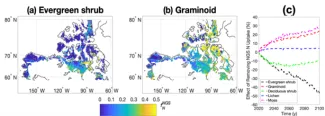Fall and wintertime root and soil biogeochemistry, which are not well represented in large-scale land models, strongly affect 21st century shrub expansion.
Plant growth and distribution in high-latitude tundra ecosystems are strongly limited by nutrient availability and are critical for projecting 21st century carbon-climate interactions. Although it has been recognized for decades in the observational community that plants continue to acquire nutrients well past when aboveground activity has ceased, most large-scale land models ignore this process. Here, NGEE Arctic researchers address the role tundra plant nutrient acquisition during the non-growing season (NGS) has on centennial-scale vegetation growth and dynamics, with a focus on shrub expansion (Riley et al., 2021). These authors apply a well-tested (including at several NGEE Arctic sites) mechanistic model of coupled plant, microbial, hydrological, and thermal dynamics that explicitly represents nutrient acquisition based on plant and microbial traits, thereby allowing a prognostic assessment of NGS nutrient uptake. They first show that the model accurately represents observed seasonality of NGS plant nutrient uptake in the NGEE Arctic Utqiaġvik site. Applying the model across the North America tundra indicates that NGS nutrient uptake is consistent with observations and ranges between ~5-50% of annual uptake, with large spatial variability and dependence on plant functional type. Importantly, NGS plant nutrient acquisition strongly enhances modeled 21st century tundra shrub growth and expansion rates. Results suggest that without NGS nutrient uptake, total shrub aboveground dominance would be ~50% lower, limited primarily by their inability to grow tall enough to maximize their inherent capacity for light competition. Evergreen shrubs would be more strongly affected because of their relatively lower capacity for nutrient remobilization and acquisition compared to deciduous shrubs. It is concluded that because most land models, including the default ELM, do not allow for wintertime plant nutrient acquisition or light competition, their projections of 21st century tundra shrubification and carbon cycling are very uncertain.
Citation: Riley, W. J., Z. A. Mekonnen, J. Y. Tang, Q. Zhu, N. J. Bouskill, and R. F. Grant. 2021. “Non-growing season plant nutrient uptake controls Arctic tundra vegetation composition under future climate.” Environmental Research Letters 16: 074047. https://doi.org/10.1088/1748-9326/ac0e63.


